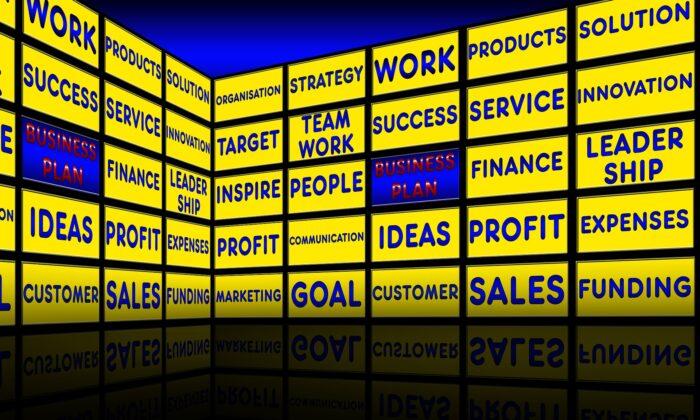 By Chris Patton
By Chris Patton
It’s no secret that most entrepreneurs are highly motivated to reach their business goals. The most successful entrepreneurs, however, find a way to get all of their employees working together to reach those business goals. That starts with ensuring their business goals are developed in such a way that employees fully understand what their part is in reaching those goals and what exactly they need to do to accomplish them. That can be challenging for entrepreneurs, especially when they seem to intuitively know what needs to be done. Employees, on the other hand, need guidance and direction.Hire the Right People, in the Right Place, for the Right Job, at the Right Time
To help employees reach your business goals, you need to become a talent manager. You need to know how to hire the best and then put them in spots where they can shine. Spotting talent often requires that we throw away outdated ways of searching for talent, or the concept that only certain experience levels will do the job well.Once you’ve hired or promoted the right employees, be sure they have the authority to complete the tasks you’ve asked them to complete. You can’t expect a newly hired junior employee to delegate tasks to a higher-level manager without there being some sort of advanced discussion and buy-in from everyone involved. Also, be sure to provide any training necessary to excel at the task and develop future skills.
Know what each employee does best and put them in roles where they can perform optimally. For example, don’t assume that your star salesperson can write advertising copy. Selling and writing are different skills. Keep your salesperson focused on selling and find a copywriting all-start to write the words.
Don’t wait until you’re in over your head to start thinking about hiring someone. It’s best to think about your hiring strategy well in advance of needing your new hire. Once you know it’s time to start hiring, think about what talent you'll need five years from now and assess the traits they will need. Hire those that can grow with your business. While past performance is one predictor of future performance, employees who adapt best are those with soft skills such as emotional intelligence. Beware of choosing employees who are just like you and use data to hire, promote and assign tasks to employees. Place a high priority in recruiting employees who can collaborate with others, rather than those who are focused only on their individual success.
Guide Employees Toward the Goal
Your employees should understand how exactly they fit in toward reaching business goals. They should feel like they are part of the big picture, not just someone entering information into a computer for reasons unknown. Help them understand their importance and the impact they have if they reach—or don’t reach—their goals. There is no time or place for secrecy when it comes to working together to reach business goals.Communicate clearly with employees about tasks delegated to them. Be sure they understand what you expect. What are the deadlines and priorities, for example? What will “done” look like? Hitting a bullseye if the target isn’t visible is impossible. Likewise, your employees will never achieve the goals if the goals themselves are unclear.
Once you’ve provided clear information about what you expect, ask them to articulate their strategy to tackle the assignment. They‘ll begin to take the lead as they develop strategies, and you’ll also be sure they’ve fully understood the assignment. Also, provide opportunities for them to ask questions and offer their own ideas.
Document expectations in writing so that both of you remember tasks and deadlines.
Keep Them Accountable
Once they understand what done looks like follow up with them on a regular basis. Hold employees accountable for their actions and their results. During the initial meeting, block off future time in the calendar for follow-up meetings.During follow-up, review their strategy for accomplishing the task and how effective the strategy has been. For example, if a salesperson’s goal is to increase sales by 5 percent, hold them accountable for key metrics, such as making more sales calls.
Decide together if those metrics are helping them reach their personal goals and continually make adjustments as needed. If you see that the employee is struggling to meet the goal, talk with them to understand why. If they need coaching or further training, find ways to provide it. Use good coaching skills such as listening, facilitating, and problem-solving to keep them on track.
When standards slip, performance slips. Be sure the employee understands that the expectation is not negotiable but that you are available to help them if they reach out. By holding employees to a high standard, you are challenging them to be the best they can be.
Also, monitor their deadline performance closely. Let them know that missing deadlines is unacceptable, as well. Continue to document the employee’s progress toward the task in writing. This creates a paper trail for rewarding those who perform well and intervening with those who are not.
Finally, if—despite all the meetings, training, and coaching—the employee still can’t manage to accomplish the task or achieve the goal, consider reassigning or replacing them. In some cases, you may have the right employee in the wrong spot. In this case, you‘ll transfer them to a spot where they’ll be able to make a stronger contribution. In other situations, however, the employee may not be the right one for your company. You'll have to fire them for the good of the entire organization. Be firm, but kind. These are real people, with other real people who may depend on them.
To achieve its goals, your business needs all its employees to work together. You need the right employees in the right places performing the right tasks. You also need to guide these employees and hold them accountable for their actions and the results. If you do these things effectively, you'll gain the respect of your employees, grow your business and reach even your most ambitious business goals.






Friends Read Free